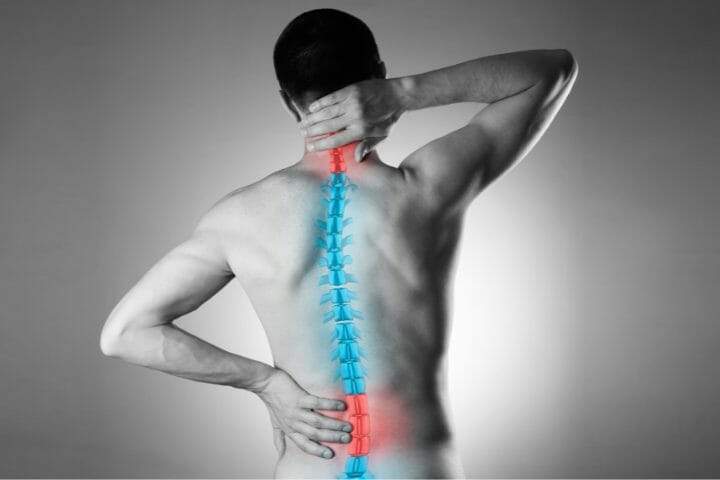Arthritis can cause your body to lose its vitality and make even simple daily tasks difficult. So, can you get disability for arthritis in the spine? Let us find out
Contents
Arthritis is a condition that can cause inflammation and pain in any joint in the body. While it most commonly affects the hands, feet, and knees, arthritis can also affect other joints, including those in the spine.
If you are experiencing chronic pain from arthritis in your spine, you may be wondering if you could qualify for disability benefits. Keep reading to learn more about how arthritis of the spine can impact your ability to work and if you could be eligible for disability benefits.

Can You Get Disability For Arthritis In The Spine?
If you have arthritis of the spine, also known as spinal arthritis, several different things can cause pain and discomfort. And yes, if your conditions are severe enough, you may be eligible for Social Security Disability benefits.
Two main types of arthritis typically affect the spine–osteoarthritis and rheumatoid arthritis. Osteoarthritis is a form of degenerative arthritis (worsens with time) where joint cartilage wears away over time.
Rheumatoid Arthritis is an autoimmune disorder where inflammation occurs due to your body’s immune system attacking itself. These conditions can cause varying levels of chronic pain and limited mobility in the spine, making working difficult or impossible. You may get benefits for these two types of arthritis as well.
You might also like to read: Can You Get Disability If You’ve Never Worked?
Disability Claims For Spinal Disorders With Compromise of a Nerve Root
If you’re looking for a disability for arthritis in the spine, you may be able to get approved for benefits under a listing.
Some spinal disorders cause your nerve root to be compromised, which can result in symptoms such as numbness, severe pain, and weakness. If your condition meets or equals one of these listings, it will qualify you for disability benefits.
To qualify for disability benefits based on arthritis in the spine, your condition must meet or equal one of the following listings. So what are the listings? Let’s take a look at them below:

Listing 1.02
Listing 1.02 in the Social Security Disability Blue Book covers arthritis. This listing covers two types of arthritis:
- Inflammatory arthritis includes conditions like rheumatoid arthritis, psoriatic arthritis, and ankylosing spondylitis
- Degenerative arthritis is the most prevalent type of arthritis and it is most commonly osteoarthritis
To get benefits based on this listing, you must show that your arthritis meets the requirements outlined in the listing. This includes having laboratory findings or x-rays that show evidence of arthritis and having joint pain and stiffness that limits your ability to function.
Listing 1.03
Listing 1.03 of the Social Security Administration’s Disability Listing of Impairments (known as the “blue book”) covers arthritis and other joint disorders.
To qualify for benefits based on this listing, your arthritis must be severe enough to limit your ability to do basic work activities. This means that your arthritis must significantly interfere with your ability to walk, lift, carry, push, pull, or otherwise perform basic physical tasks.
In addition, you must have medical documentation of your arthritis, such as x-rays or MRIs, and you must be able to prove that your arthritis has lasted or is expected to last for at least one year.

Listing 1.04
If you have arthritis of the spine, you may be eligible for certain benefits from the government. Listing 1.04 in the Social Security Administration’s (SSA) Blue Book outlines your requirements to meet to qualify.
To qualify under Listing 1.04, your arthritis must be severe enough to limit your ability to do basic work activities. This includes things like walking, sitting, and lifting. You must also have lumbar spinal stenosis, spinal arachnoiditis, or nerve root compression. You must also have evidence of arthritis in at least two joints and evidence of joint deformity.
If you meet all the requirements of Listing 1.04, you will be automatically approved for benefits. There is no need to go via a lengthy review process. However, if your arthritis does not meet the listing requirements, you may still be eligible for benefits if you can prove that your condition meets one of the SSA’s other criteria.
Lumbar Stenosis Resulting in Compromise of the Cauda Equina
Lumbar stenosis is a degenerative condition that narrows the spinal canal and puts pressure on the nerves within the spine. This can lead to pain, weakness and numbness, in the legs.
If left untreated, lumbar stenosis can compromise the cauda equina, a group of nerves at the end of the cord that controls bowel and bladder function and sexual function. In severe cases, lumbar stenosis can cause paralysis of the legs.
If you suffer from lumbar stenosis that has resulted in the compromise of the cauda equina, you may be eligible for Social Security disability benefits under listing 1.16. To qualify for benefits, you must show that your condition is severe enough to prevent you from working.
You might also like to read: Can You Get Disability For Spondylosis?
Listing Reconstructive Surgery of a Major Weight-Bearing Joint
Yes, you may be eligible for disability benefits if you have arthritis in your spine that requires reconstructive surgery of a major weight-bearing joint. The Social Security Administration (SSA) has a specific listing for this condition, known as Listing 1.18.
To qualify for disability benefits under this listing, you must show that your arthritis has caused changes in your spine, leading to instability in one or more major joints. This must be documented by imaging studies (such as x-rays or MRIs) and confirmed by surgical reports.
In addition, you must show that the surgery you had was unsuccessful in alleviating your symptoms and improving your function. You will need to submit medical records documenting the surgery and any follow-up appointments and tests you have had.

Listing Abnormality of a Major Joint
Yes, you can get disability for arthritis in the spine if your condition meets or equals a listing in the Social Security Administration’s (SSA) “Blue Book.” The listings for abnormalities of major joints are found under listing 1.00 of the Blue Book.
Can You Get Disability For Arthritis in the Neck?
Is Arthritis In the Neck a Disability?
Arthritis in the neck can be a debilitating condition, causing pain, stiffness, and inflammation. If you have arthritis in the neck, you may be wondering if this qualifies as a disability. The answer depends on several factors, including the severity of your condition and how it affects your ability to work.
In general, arthritis is considered a disability if it significantly limits your ability to perform basic daily activities or cripplingly interferes with your ability to earn a living. For instance, if you can no longer turn your head to back up your car or brush your teeth properly due to neck pain, you would likely qualify for disability benefits.
Likewise, suppose chronic neck pain and stiffness make it impossible to sit or stand for long periods or perform your job duties. In that case, you may also be eligible for disability.

Can You Get Disability for Arthritis in Your Back?
If you have arthritis in your back, you may be eligible for disability benefits through the Social Security Administration (SSA). Different types of arthritis in the lower back can cause painful symptoms and make it difficult to perform daily tasks.
To qualify for disability benefits due to arthritis in your back, you must meet specific medical criteria set by the SSA. You will need to provide information about your medical history and undergo a physical examination, including X-rays or other diagnostic tests. In addition, there is an evaluation process that looks at factors including age, work experience, education level, and other factors.
Can I Still Get Benefits If My Arthritis Doesn’t Meet Any of the Listings?
If your arthritis doesn’t meet any of the listings, you may still be found disabled if your condition has severely limited your ability to work. The SSA will consider your medical records and testimony from you and people who know you to decide if you are disabled.
If your arthritis is causing you pain and limiting your ability to function, you may still be eligible for Social Security disability benefits. The Social Security Administration (SSA) will consider all of the evidence in your case, including your medical records and testimony from you and people who know you, to decide if you are disabled.
You might also like to read: Can You Get Disability For Neuropathy?
How To Apply for SSD Benefits due to Arthritis
Arthritis is a prevalent condition that can affect people of all ages, from young children to seniors. If you have been diagnosed with arthritis and your symptoms prevent you from working, you may be eligible for Social Security Disability benefits.
Applying for disability benefits through the Social Security Administration can seem daunting, but it doesn’t have to be! This section will explain how to apply for SSD benefits due to arthritis and what factors the SSA will consider when determining your eligibility.
The first step in applying for SSD benefits due to arthritis is completing a detailed application and medical questionnaire. The form will ask about your diagnosis, symptoms, treatment history, work history, etc. Include all treatment records, medical reports, and other documents to support your claim. It’s also essential to provide information about your work history and any medications you may be taking.
If the SSA determines that you meet their definition of “disabled,” they will schedule a disability hearing to review your case further. At this hearing, an Administrative Law Judge or state agency representative will ask questions about your condition and its effect on your ability to work.
You will have the opportunity to bring witnesses or a lawyer who can present evidence on your behalf, but it is not required for you to do so. The judge will decide whether or not you are eligible for SSD benefits.
If you are approved for SSD benefits, you will receive a monthly check to help offset the cost of living. Your benefit will depend on your prior work history and earnings. You may also be eligible for Medicare coverage if approved for SSD benefits.

Frequently Asked Questions
1. How hard is it to get a disability for arthritis?
Many factors play into how difficult it is to get a disability for arthritis. The severity of the condition, the age of the individual, and the type of arthritis all contribute to the likelihood of being approved for benefits. However, it can be pretty challenging to obtain a disability for this condition.
This is because arthritis is often seen as a manageable condition that does not necessarily prevent an individual from working. Individuals must typically provide extensive medical evidence to prove that their arthritis is severe enough to warrant disability benefits.
2. type of arthritis qualifies for disability?
There are many types of arthritis, and each can have different effects on a person’s ability to function. Some types of arthritis may make it difficult to walk or climb stairs, while others may cause pain and stiffness that makes it hard to grip objects or perform other daily activities. Arthritis such as rheumatoid arthritis, spinal osteoarthritis, and osteoarthritis qualify for benefits.
3. Does arthritis of the spine get worse?
The pain and stiffness associated with arthritis can gradually worsen, and the condition can also lead to other serious problems such as deformity, disability, and even paralysis.
Spinal conditions can certainly worsen over time, especially if left untreated. If you are concerned that your arthritis may be progressing, it is essential to see a doctor for an evaluation to receive the appropriate treatment.
4. What can be done for arthritis in the spine?
Many things can be done to help ease the pain and discomfort of arthritis in the spine. Here are some suggestions:
Stay active. Exercise can help to keep the joints flexible and strong.
Use heat or cold therapy. This can help to relieve pain and inflammation.
Try over-the-counter pain relievers. These can help to reduce pain and swelling.
Talk to your doctor about prescription medications. There are many options available that can help to improve symptoms.
Have regular checkups with your doctor. This will help monitor the condition and ensure that it is not getting worse.
Consider other methods of treatment, such as acupuncture or physical therapy. These can help to ease pain and improve the overall quality of life.
If you have arthritis in the spine, it is essential to take steps to manage your condition. Talk to your doctor about options that are right for you, and remember that there is always support available if needed. You can do many things at home to help decrease your symptoms and improve your overall quality of life.
Wrap Up
Arthritis in the spine is a major spinal disorder which can several restrict your range of motion and stop you from indulging in gainful activity. The government recognizes this, and as long as you can meet the necessary medical conditions laid out in the blue book, you can certainly get social security for it.
Thank you for reading, we hope we have been able to cover all your doubts and questions regarding arthritis in the spine and how to claim disability for it. If you have any further queries, please write to us.
